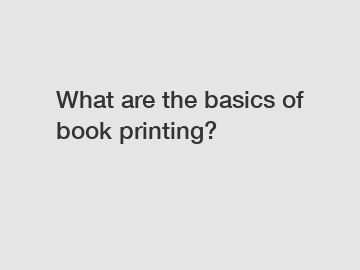What are the basics of book printing?
Book printing is a complex and fascinating process that involves various steps to bring a manuscript to life. Understanding the basics of book printing can help authors, publishers, and anyone interested in the publishing industry to appreciate the craftsmanship and effort that goes into creating physical books. From file preparation to binding, every stage of book printing plays a crucial role in producing high-quality printed materials that readers can enjoy for years to come.
**Prepress Preparation**.
Before a book can be printed, proper file preparation is essential. This includes typesetting, formatting, and layout design to ensure that the text and images appear correctly on the page. Authors or designers must also consider paper size, margins, fonts, and any special printing effects that they wish to include in the final product. Additionally, the text must be proofread and edited to ensure accuracy and consistency throughout the manuscript.

**Printing Process**.
Once the files are ready, the printing process can begin. There are several methods of printing used in the book industry, including offset printing and digital printing. Offset printing is a traditional method that involves transferring ink from a plate to a rubber blanket before applying it to the paper. Digital printing, on the other hand, uses electronic files to directly print the text and images onto the paper. Each method has its own advantages and is chosen based on factors such as print volume, color options, and turnaround time.
**Binding and Finishing**.
After the pages have been printed, the next step is binding the book. There are several types of binding methods, including perfect binding, saddle stitching, and case binding. Perfect binding is commonly used for paperback books, where the pages are glued together at the spine. Saddle stitching involves stapling the pages together along the fold, while case binding creates a durable hardcover book with a sewn or glued spine. Once the book is bound, it may undergo additional finishing processes such as trimming, embossing, or laminating to enhance its appearance and durability.
**Quality Control**.
Throughout the book printing process, quality control is essential to ensure that the final product meets the desired specifications. Printers may perform color checks, page inspections, and binding tests to identify any issues that need to be addressed before the books are shipped to customers. Quality control measures help maintain consistency and accuracy in print production, leading to a finished product that meets or exceeds industry standards.
**Conclusion**.
In conclusion, the basics of book printing involve a series of interconnected steps that transform a manuscript into a physical book. From prepress preparation to binding and finishing, every stage of the printing process requires attention to detail and expertise to produce high-quality printed materials. Understanding the fundamentals of book printing can help authors and publishers navigate the publishing industry and create beautiful books that captivate readers. By appreciating the craftsmanship and dedication that goes into book printing, we can all develop a greater appreciation for the printed word and the art of publishing.
If you are interested in learning more about book printing or are ready to start your book printing project, please contact us for more information.
If you want to learn more, please visit our website hardcover book printing with embossing, linen hardcover book printing, cnprint.

Comments